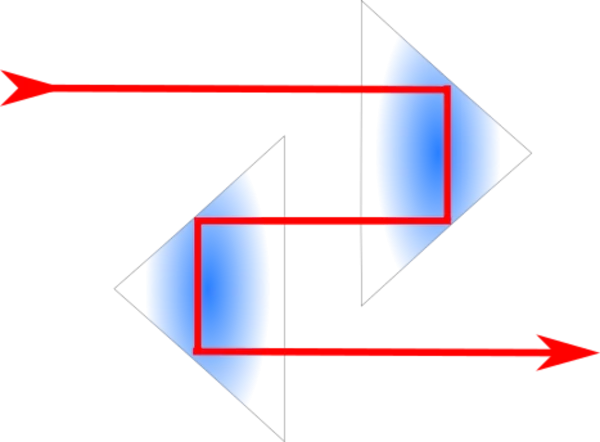

Binoculars
Binoculars are a class of optic that allow us to see distant objects with better clarity. Being able to use two eyes results in a greater field of view amongst other things.
Table of Contents
Binoculars
Binoculars, also known as field glasses or binocular telescopes, are instruments used to magnify distant objects by using two telescopes mounted side-by-side and aligned to point in the same direction. Like scopes, they allow the viewer to see objects that are far away as if they were closer, making them a useful tool for a variety of activities besides hunting. Birdwatching, boating, and watching the cricket.
Binoculars work by gathering and focusing light from the object being viewed and directing it into the user’s eyes. This is achieved through the use of lenses and prisms, which are specially shaped pieces of glass or other transparent materials that refract light in a specific way. The objective lenses, which are located at the front of the binoculars, gather light from the object being viewed and focus it onto the prisms, which then direct the light towards the eyepieces or ocular lens, where the user looks through to see the magnified image.
Things consider when choosing a pair of binos:
- magnification
- objective lens size
- and the type of prism used.
The magnification refers to how much an object appears to be enlarged, and it is indicated by a number on the binoculars, such as 8x or 10x. A higher magnification means that the object will appear closer, but it also means that the image will be more difficult to hold steady due to the increased magnification.
The objective lens size refers to the diameter of the front lenses and is typically indicated by a number followed by the letter “mm,” such as 30mm or 40mm. A larger objective lens size will allow more light to enter the binoculars, resulting in a brighter image, but it will also make the binoculars larger and heavier.
So a reference to a typical binocular specification might look like:
- 8 x 40 = 8 times magnification with a 40 mm objective lens.
or
- 6 x 30 = 6 times magnification with a 30 mm objective lens.
and so on.
The type of prism used can also affect the performance of the binoculars. There are two main types of prisms:
Porro prisms are typically found in cheaper binoculars and result in a wider field of view, but they can also cause some distortion in the image.

Roof prisms, on the other hand, are more expensive but result in a more compact design and a higher-quality image.


Binoculars are available in a wide range of prices and qualities, so it’s up to your needs and budget when choosing the right pair. Some things to consider:
- The amount of light available, a bright Aussie summer day or mid winter in South Tassie.
- Weight and size may be an issue if you are going to be carrying a ton of gear on foot.
- Night vision binoculars may be the ticket for use in low light conditions.
- or thermal imaging binoculars that detect heat signatures (handy in tight scrub).

Porro Prisms
Porro prisms are a type of optical element that are used in binoculars, and other optical instruments. They are named after the Italian optician Ignazio Porro, who invented them in the 19th century.
Porro prisms are made of two right-angle prisms arranged in a specific way, with the long edges of the prisms parallel to each other. The prisms are oriented so that one of the faces of one prism is in contact with one of the faces of the other prism, and the other faces are angled at 90 degrees to each other.
When light enters a porro prism, it is first refracted (bent) by the first prism, and then it is reflected off the angled face of the second prism. This causes the light to be both refracted and reflected, which results in the light being directed at a right angle to its original direction. Porro prisms are used in telescopes and binoculars to bend the light coming from the eyepiece so that it is aligned with the viewer’s eye.
Porro prisms are often used in telescopes and binoculars because they are relatively simple and cheap to make, and they still provide good image quality. They are also relatively compact, which makes them well-suited for use in portable optical instruments. They are however, not as efficient at transmitting light as some other types of prisms, such as roof prisms, which means that they can introduce some loss of brightness in the image.

Roof Prisms
Roof prisms are another type of optical element used in binoculars that are named for their shape, which is supposed to resemble the roof of a house (bit of a stretch if you ask me, but what do I know?).
Roof prisms are made of two right-angle prisms arranged in a way, with the long edges of the prisms perpendicular to each other. The prisms are oriented so that the hypotenuse (angled) faces of the prisms are in contact, and the other faces are parallel to each other.
When light enters a roof prism, it is refracted (bent) and reflected off the angled faces of the second prism. This, as with Porro prisms, causes the light to be directed at a right angle to its original direction. Roof prisms are also used in telescopes and binoculars to bend the light coming from the eyepiece so that it is aligned with the viewer’s eye.
Roof prisms are often used in place of Porro prisms because they are more efficient at transmitting light than Porro prisms. This means that they introduce less loss of brightness in the image. However, they are more difficult and expensive to manufacture than Porro prisms, and they are typically somewhat less compact.
Features
There are many different features that you can look for in a pair of binoculars, such as:
- field of view
- magnification
- waterproofing
- fog proofing and
- image stabilization.
Field of view
The field of view of a pair of binoculars is a measure of how much of the scene you can see through the binoculars at a given distance.
The field of view is usually expressed in feet at a distance of 1,000 yards. However, it can also be expressed in meters at a distance of 1,000 meters. To convert from feet to meters, you can use the following formula:
Field of view in meters = (Field of view in feet) x (0.3048)
For example, if a pair of binoculars has a field of view of 350 feet at a distance of 1,000 yards, you can convert this to meters as follows:
Field of view in meters = (350 feet) x (0.3048) = 107.1 meters
So, the field of view of these binoculars would be 107.1 meters at a distance of 1,000 meters.
A wider field of view means you can see more of the scene at once, which can be useful for picking up a target.
Magnification
Magnification refers to how much a pair of binoculars enlarges an object when you look through them. For instance, if a pair of binoculars has a magnification of 8x, it will make an object appear 8 times closer than it would without the binoculars. So, if you look at an object that is 1,000 meters away through a pair of 8x binoculars, it will appear as if it is only 125 meters away.
Water proofing
Waterproof binoculars are essential for hunting in wet or humid environments, as they will prevent moisture from entering the lenses and causing them to fog up.
Fog proofing
Fog proofing is also important for the same reason, as it will prevent the internal optics from fogging up when you go from a cold environment to a warm one.
Image stabilization
Image stabilization is a useful feature for hunting on the move, as it will help to keep the image steady and reduce the effects of hand shake.
Summary
Overall, binoculars are a versatile and useful tool that can enhance your ability to see and appreciate the world around you.
Like telescopic sights, binoculars have many similar qualities such as objective lens, ocular lens etc.
In my experience in the field, binoculars play an important role in finding and identifying a target. Thanks largely to the fact you can use both eyes and therefore cover more ground than a monoscope. Once the target is found then you can work on the nitty gritty task of aiming for it with scope or open sights.
Whether you are an a hunter, a cricket tragic or just someone who enjoys the outdoors, a good pair of binoculars can provide hours of enjoyment and help you see things you might otherwise have missed.
FAQ (Frequently Asked Questions)
What is the "magnification" of a pair of binoculars?
The magnification of a pair of binoculars is the number of times that an object appears to be magnified when viewed through the binoculars. For example, if a pair of binoculars has a magnification of 8x, then an object that is 1,000 feet away will appear to be only 125 feet away when viewed through the binoculars.
What is the "objective lens size" of a pair of binoculars?
What is the "field of view" of a pair of binoculars?
The field of view of a pair of binoculars is the width of the area that you can see through the binoculars when looking at a distant object. It is usually expressed in feet at a distance of 1,000 yards. A wider field of view allows you to see more of the scene at once, which can be useful for things like hunting, birdwatching or sports events.
What is the "exit pupil" of a pair of binoculars?
What is "image stabilization" in binoculars?
Image stabilization is a feature that helps to reduce the amount of shaking and blurring in the image when using binoculars. It can be especially helpful when using high magnification binoculars or when viewing objects that are in motion. There are two main types of image stabilization: mechanical and electronic. Mechanical image stabilization uses moving parts to physically stabilize the image, while electronic image stabilization uses sensors and motors to electronically stabilize the image.
Photo Credits: Jonathan Cutrer & John Vowles | Unsplash